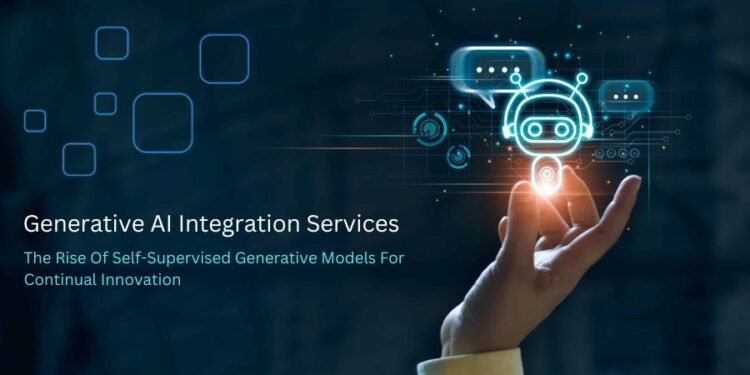The Rise Of Self-Supervised Generative Models For Continual Innovation

Generative AI represents an evolution in machines’ ability to learn and autonomously produce novel, high-quality outputs. Self-supervised generative models trained on massive datasets are demonstrating astonishing creative capabilities in domains like text, images, audio, and more. As these AI systems rapidly advance, they hold tremendous potential for continual innovation by augmenting human capabilities across industries.
In this comprehensive guide, we will examine the ascendance of self-supervised generative models and how they are transforming innovation cycles through generative AI integration solutions and other approaches.
The Generative AI Breakthrough:
Generative AI refers to models that create new, realistic data based on patterns learned from training datasets, rather than just classifying or analyzing existing data.
Self-supervised learning has propelled their capabilities further by enabling models like DALL-E 2, GPT-3, and AlphaCode to ingest billions of parameters from the internet without human labeling or supervision. Their ability to generate human-like creative outputs trained solely on observing patterns in enormous datasets represents a significant advance. As computing power grows, so will the innovation potential of these self-supervised generative models.
Transforming How AI Learns:
In the past, most AI models were discriminative, aimed at distinguishing between predefined classifications or predictions based on labeled training data. This constrained scope led to limited real-world utility. The unsupervised learning approach used in self-supervised generative models provides two key differentiators: First, by removing the dependency on labeled data, models can ingest orders of magnitude more data from the entire internet. It exposes them to substantially more contexts, concepts, and interconnections. Second, the objective moves from just classifications to the actual synthesis of realistic, novel artifacts. This focus on creative production versus statistical discrimination enables unprecedented capabilities. Together, self-supervised learning and generative modeling provide the foundation for the next generation of inventive AI.
Fueling An Explosion Of AI Creativity:
Generative models have demonstrated incredible creative feats across multiple domains in recent years. DALL-E generates striking images from text captions, even accurately representing complex attributes like poses and lighting. Its successor, DALL-E 2, produces photorealistic images with fine details at mega-resolutions.
AlphaCode writes full software programs from descriptions in mere seconds, automating rote coding tasks. GitHub Copilot suggests whole syntax and code blocks from comments, accelerating software development. GPT-3 crafts human-like text content, including news articles, poetry, dialogues, and computer code based on text prompts. Jasper generates voices indistinguishable from real humans based on just a 3-second sample, revolutionizing text-to-speech. MuseNet composes musical compositions in any style that trained musicians find captivating. The diversity of high-quality creative outputs these models can generate autonomously points to a paradigm shift in what AI can accomplish.
Unlocking New Possibilities With Integration Solutions:
To channel the innovation potential of generative models for real-world problems, seamless integration into business workflows is crucial. Generative AI Integration Solutions designed ground-up for commercial usage can make these models accessible to enterprises in impactful yet controlled ways. Some possibilities that such integration enables include: Automating rote design tasks—branding ideation, logo design, and graphic layouts—which saves designers’ time for higher-order work. Models both generate and intelligently filter creative options, with humans steering the overall direction. Assisting marketers by producing diverse, nuanced messaging tailored to microsegments can be identified through analytics. This amplifies creativity at scale. Code auto-completion suggests contextually relevant code snippets to boost developer productivity. Integrations with IDEs make adoption seamless. Automated data synthesis generates realistic data for model training, converting sparse datasets into abundant resources for machine learning. Specialized integration solutions channel AI creativity into enhanced human workflows rather than replacing people, unlocking new sources of innovation, productivity, and insight.
Considerations For Responsible Adoption:
Like any powerful technology, adopting generative AI requires thoughtful diligence to address risks and maintain trust. Carefully assess the generated outputs for harmful, biased, or misleading content before dissemination. Watermark the AI-produced artifacts to maintain transparency on origin as use increases. Track the data provenance and transfers through access controls and auditing to prevent misuse. Monitor for drifting model behavior that distorts outputs due to skewed datasets. Enable user feedback channels to flag concerns around unsafe or abusive AI content. Frequent AI ethics reviews to address emergent concerns proactively as capabilities advance. With a focus on responsible adoption, generative models can be safely harnessed for positive innovation.
Accelerating Innovation Velocity:
The exponential growth in new knowledge and data makes sustaining innovation cycles difficult. Generative models provide a scalable solution to this challenge. Produce commercially viable ideas faster—logos, ads, data visualization, and digital content. Democratize ideation beyond just creatives. Reduce concept-to-production timeframes with computer-assisted design and rapid prototyping. Convert immense information into compressed insights humans can readily build upon. Eliminate the drudgery that bogs down innovators—data cleaning, rote design, mundane research. Complement specialized human creativity with AI’s untiring idea generation and iteration. Foster collaboration between distributed teams through quickly produced artifacts. Provide personalized education at scale to develop skills needed for leveraging AI. With possibilities multiplying exponentially, generative AI integration solutions fuel enduring human-led innovation.
Enhancing Domain Expertise:
Generative models can amplify human expertise by supplying relevant knowledge on demand. Intelligently searching scientific literature to discover relevant patterns and concepts for research. It augments subject mastery. Technicians capture field issues through images and descriptions for AI to propose solutions based on repair patterns in massive historical ticket data. It improves first-time fix rates. Lawyers use AI collaborators to analyze how similar cases were argued to uncover winning strategies. It increases case familiarity. Generative lecture preparation identifies the most compelling examples and explanations from verified sources to include for optimal knowledge transfer and improved teaching quality. Rather than replacing specialists, AI becomes their partner, enhancing expertise with data and connections beyond personal limitations.
Conclusion:
The advent of self-supervised generative AI represents a tipping point in machines augmenting, rather than replacing, human capabilities for exponential innovation. Integration solutions that tailor these breakthrough models for real-world usage in responsible ways will transform innovation cycles across industries. With humans providing strategic direction and generative AI amplifying imagination and knowledge at scale, we can look forward to new horizons of creativity, efficiency, and progress.






